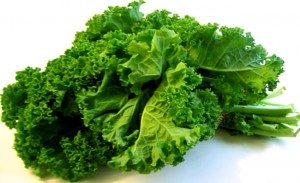Kale or borecole is rich in numerous health benefiting polyphenolic flavonoid compounds such as lutein, zeaxanthin, and beta-carotene, and vitamins than found in any other green leafy vegetables. Kale provides rich nutrition ingredients that offer protection from vitamin A deficiency, osteoporosis, iron deficiency anemia, and believed to protect from cardiovascular diseases and, colon and prostate cancers.
Tuscan kale, also known as cavalo nero, is a popular winter season greens in the Northern parts of Italy. It features distinctive very long, curly, blue-green leaves with embossed surface resembling dinosaur skin, giving its name as dinosaur kale.
Benefits of Eating Kale or Borecole
Di-indolyl-methane (DIM), a metabolite of indole-3-carbinol has been found to be an effective immune modulator, anti-bacterial and anti-viral agent through its action of potentiating “Interferon-Gamma” receptors.
Borecole is very rich source of ß-carotene, lutein and zeaxanthin. These flavonoids have strong anti-oxidant and anti-cancer activities. Beta-carotene is converted to vitamin A in the body.
Zeaxanthin, an important dietary carotenoid, is selectively absorbed into the retinal macula lutea in the eyes where it is thought to provide antioxidant and protective light-filtering functions. Thus, it helps prevent retinal detachment and offers protection against “age related macular degeneration disease” (ARMD) in the elderly.
It is very rich in vitamin A, 100 g leaves provide 512% of RDA. Vitamin A is required for maintaining healthy mucus membranes and skin and is essential for vision. Foods rich in this vitamin offer protection against lung and oral cavity cancers.
Adequate vitamin-K levels in the diet helps limiting neuronal damage in the brain; thus, has established role in the treatment of patients suffering from Alzheimer’s disease.
100 g of fresh leaves contain 120 mg or 200% of daily-recommended levels of vitamin C. Scottish curly leaf variety yet has more of this vitamin, 130 mg/100g. Vitamin C is a powerful antioxidant, which helps body develop resistance against infectious agents and scavenge harmful oxygen free radicals.
This leafy vegetable is notably good in many B-complex group of vitamins such as niacin, vit.B-6 (pyridoxine), thiamin, pantothenic acid, etc that are essential for substrate metabolism in the body.
It is also rich source of minerals like copper, calcium, sodium, potassium, iron, manganese, and phosphorus. Potassium is an important component of cell and body fluids that helps controlling heart rate and blood pressure by countering effects of sodium. Manganese is used by the body as a co-factor for the antioxidant enzyme, superoxide dismutase. Iron is required for cellular oxidation and red blood cell formation.
Vitamin K
Kale provides a whopping dose of vitamin K (providing 1327% of the RDA in one cup), which is necessary for the synthesis of osteocalcin, a protein that strengthens the composition of our bones. Vitamin K also prevents calcium build-up in our tissue that can lead to atherosclerosis, cardiovascular disease and stroke. Finally, vitamin K is essential for synthesizing sphingolipid, the fat needed to maintain the myelin sheath around our nerves, and therefore our nervous system as a whole.
Vitamin A
With over 192% of the RDA of vitamin A, one cup of kale is an effective antioxidant, boosts immunity, maintains healthy bones and teeth, prevents urinary stones, and is essential to our reproductive organs.
Vitamin C
Vitamin C, which one cup of kale heartily provides (over 88% of our RDA), is not only a powerful antioxidant, but also lowers blood pressure, ensures a healthy immune system, and fights against age-related ocular diseases, such as cataracts and macular degeneration.
Good for Diet and Digestion
One cup of kale has only 36 calories and zero grams of fat, which makes it a great diet aid. Furthermore, one cup contains nearly 20% of the RDA of dietary fiber, which promotes regular digestion, prevents constipation, and lowers blood sugar and curbs overeating. Finally, kale contains the glucosinolate isothiocyanate (ITC) that fights the formation of H. pylori (Helicobacter pylori), a bacterial growth in the stomach lining that can lead to gastric cancer.
Fight Cancer
Not only do kale’s antioxidant and anti-inflammatory qualities work together to prevent and even combat cancer, a healthy diet of kale also provides glucosinolates, which have been shown to prevent colon, breast, bladder, prostate, ovarian cancers, as well as gastric cancer.
Cardiovascular Support
The high fiber content of kale lowers our cholesterol by binding with bile acids that the liver produces from cholesterol for digesting fat. Because many of these bile acids are coupled with fiber, the liver is charged with producing more bile acid to digest fat, and therefore requires more cholesterol to so, ultimately lowering the amount of cholesterol within our bodies.
Antioxidants
Kale is a superstar in the arena of carotenoids and flavonoids, two powerful antioxidants that protect our cells from free radicals that cause oxidative stress. The key flavonoids kaempferol and quercitin (not to dismiss the 45 other distinctive flavonoids in kale) have also been shown to specifically fight against the formation of cancerous cells. With the addition of high doses of well-known antioxidants like vitamin C, vitamin A, and manganese, kale is certainly a smart choice in the battle against cellular oxidation.
Anti-Inflammatory
One cup of kale provides about 10% of the RDA of omega-3 fatty acids that helps regulate the body’s inflammatory process. A megadose of vitamin K further aids to fight against excessive inflammatory-related problems, such as arthritis, autoimmune disorders, and asthma.
Detox
The isothiocyanates (ITC) from glucosinolates found in kale aid in both phases I and II of the body’s detoxification process. The high sulfur content of kale has further been shown essential for phase II of detoxification.











